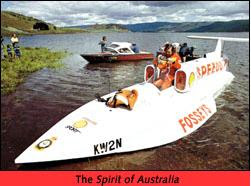 The World Water Speed record, like the air speed record, is decades old. Australian Ken Warby set the record in 1978 when he averaged 317.60 mph in a 27-foot jet-powered hydroplane called "Spirit of Australia." The official speed test, which consists of two back-to-back runs over a one-kilometer straight-away, took place on Blowering Dam in New South Wales, Australia. And where did Warby design and build this hydraulic masterpiece? Underneath a tree in the back yard of a house he was renting in suburban Sydney. "There was a canvas sheet I used to throw over it when it rained," he told the press.
The World Water Speed record, like the air speed record, is decades old. Australian Ken Warby set the record in 1978 when he averaged 317.60 mph in a 27-foot jet-powered hydroplane called "Spirit of Australia." The official speed test, which consists of two back-to-back runs over a one-kilometer straight-away, took place on Blowering Dam in New South Wales, Australia. And where did Warby design and build this hydraulic masterpiece? Underneath a tree in the back yard of a house he was renting in suburban Sydney. "There was a canvas sheet I used to throw over it when it rained," he told the press.
Attempts at beating Warby's record have come at a high price. In 1980, the previous water speed record holder, Lee Taylor, tried to reclaim his title in a 2.5 million dollar rocket-boat called "Discovery II." The missile-shaped craft was constructed of aluminum, titanium and stainless steel and was powered by a rocket engine that burned hydrogen peroxide fuel. On paper, the power plant generated 8,000 pounds of thrust -- or 16,000 horsepower. Taylor believed his boat would surpass 600 mph.
The trial took place November 13, 1980 on Nevada's Lake Tahoe. Discovery II roared through its first pass at 269.85 mph and was decelerating when it appeared to hit a swell. Witnesses reported that the boat veered to the left and suddenly disintegrated, vanishing under the surface of the lake in a matter of a few seconds.
Craig Arfons, a former automotive drag racing champion, was the next to take up the challenge. In 1989, he put the finishing touches on a jet hydroplane called "Rain-X Record Challenger," which boasted a lightweight composite hull and a jet engine that could deliver 5,500 horsepower with the afterburner lit. Arfons calculated that the boat's favorable thrust-to-weight ratio would give it a 200 percent power advantage over Warby's record-setting boat.
The record attempt took place on Jackson Lake near Sebring, Florida. Members of Arfons' crew say his boat reached a speed of 263 mph before it became airborne and began to cartwheel across the mirror-smooth lake. Arfons tried to deploy a safety parachute, but the angle at which his boat was traveling prevented the parachute from opening. Arfons was killed as his boat shattered around him.
Recently Warby, now 58, has announced his intention to push his World Water Speed Record even higher with a new boat currently under construction. "I'm far too young to be in a rocking chair, so I thought I'd get back in the cockpit."
